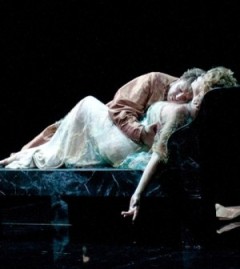Claudio Monteverdi - L’Incoronazione di Poppea (Alan Curtis) [2011]
Claudio Monteverdi - L’Incoronazione di Poppea (Alan Curtis) [2011]

L’Incoronazione di Poppea - Firenze 2011 Alan Curtis Cast: Poppea - Susan Graham Nerone - Jeremy Ovenden Fortuna e Valletto - Serena Malfi Virtù e Pallade - Anna Kasyan Amore - Francesca Lombardi Mazzulli Ottone - Anders Dahlin Arnalta - Krystian Adam Ottavia - José Maria Lo Monaco Nutrice - Nicola Marchesini Seneca -Matthew Brook Drusilla - Ana Quintans Littore e 1° Console - Matteo Ferrara Damigella - Maria Laura Martorana Lucano e 1° Soldato - Nicholas Phan Liberto - Vittorio Prato 2° Soldat - Juan Sancho 2° Console - Nicolò Ayroldi 1° Tribuno - Saulo Garcia 2° Tribuno - Davide Siega Familiari di Seneca - Margherita Puliga Orchestra del Maggio Musicale Fiorentino Alan Curtis – conductor
The only disputed fact about L’incoronazione di Poppea is that it was first performed at the Teatro SS. Giovanni e Paolo in Venice during the Carnival season of 1643. The musical attribution to Claudio Monteverdi derives only from two seventeenth century catalogues, and up until recently it has never been questioned.
In the last few decades, on the contrary, a deeper study of the score led to more intense doubts as to the true paternity of this masterpiece. One of the leading Italian scholars, Lorenzo Bianconi, now can firmly state that “no proof allows to attribute the opera, wholly or in part, to Monteverdi”. Baroque specialist René Jacobs has a softer stance, believing L’incoronazione di Poppea to be the result of a common work of a number of composers under Monteverdi’s supervision, transferring to the music a work procedure more common in the visual arts world.
The critical edition of the score used for the current Florentine performance, authored by Alan Curtis (who also conducted it), and published in 1989 bears the description “Music attributed to Claudio Monteverdi and Francesco Sacrati”.
It is common knowledge that two manuscript sources, in addition to numerous versions of the libretto, exist of L’incoronazione di Poppea. Both were published posthumously in 1651 and 1656, in Naples and Venice respectively. The only direct source is a “scenario”, a detailed plot summary; printed in 1642. None of these three publications mention Monteverdi; neither the Venetian “scenario”, nor the Neapolitan edition of the score assign the authorship of the libretto to Gian Francesco Busenello, who will receive his due credit several years later in his opera omnia Le ore ociose.
Current general consensus has it that Francesco Sacrati, Francesco Cavalli, Benedetto Ferrari, who in his own 1641 Pastor regio had set to music the duet “Pur ti miro, pur ti godo” are the composers that most likely – and until future discoveries – collaborated with the seventy-six year old maestro.
What’s more, neither of the two existing manuscripts is comparable to what is normally considered a full score, as the vocal lines are accompanied exclusively by a basso continuo , with rare additional parts only where the refrains appear.
It is such an absence of certainties that makes each new production of Poppea so stimulating, because it allows an opera company or a conductor an enormous platitude of choices. Once the decision is made as to which edition to follow, or at least base oneself on, the harmony, counterpoint, instrumentation and continuo realization must be written ex novo. Conductors will be able to avail themselves of the over twenty editions so far published or prepare one themselves. Philological studies have not only focused on the instrumental writing, but also the voice types, or registers, to which the numerous characters of the opera must be assigned. Nerone and Ottone are roles written for castrato, soprano and contralto respectively; Valletto (the forerunner of the wildly successful and long-lived page-boy role) and Amore are two female sopranos. As regards women’s voices, in exactly the same way as both his contemporaries and predecessors, Monteverdi uses two: the contralto and a type of voice which is soprano in name but never sings in very high tessituras or over a very wide range, and in any event coincides with the mezzo-soprano voice. Some female figures of the grieving, suffering type, and women of relatively mature age (Ottavia) come decidedly into this vocal category. Poppea, on the other hand, although she sings in a very central tessitura, already suggests what we call a lyric soprano. With regard to the contralto voice, Monteverdi uses it for the role of the nurse Arnalta, having her sing a very low tessitura with a range that for practical purposes is confined to the lowest octave of this type of voice. Both Arnalta and the Nutrice (Ottavia’s nurse) are written in the C clef, which nowadays means for contralto or for tenor, depending if the centre of the clef lies on the third or fourth lines.
As mentioned earlier, Alan Curtis has used his own critical edition of the score, first performed in Florence in the year 2000 by Ivor Bolton. This time, Mr. Curtis has decided to shed some of “his own” music by eliminating two deities, Venere, and Mercurio. Curtis employs fourteen instruments, favouring the dry timbres of harpsichords, lutes and chitarrones. Growing up on the legendary 1974 Telefunken recording by Nikolaus Harnoncourt, I cannot deny I missed the variety offered by his employing woodwinds and brass such as descant recorders, fifes and dulcians. Apart from this relative colour slenderness, Curtis shapes Poppea’s music with a richness of rhythms and contrasts, which contribute to the advancement of a tight and even breathtaking action, even in the incredible accumulation of situations and characters declaiming the representations of the affections according to the “concordance of the discordances” so dear to the Baroque aesthetics. --- opera-britannia.com
download: uploaded yandex 4shared mediafire solidfiles mega filecloudio








